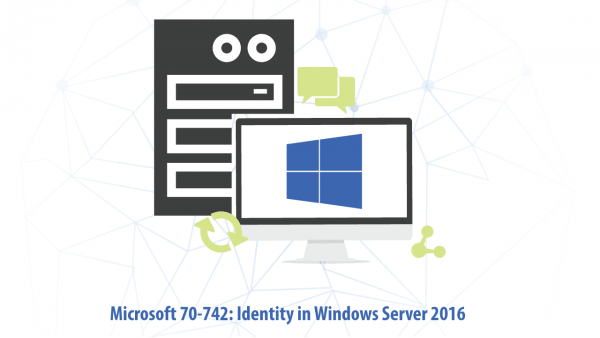Identity in Windows Server 2016 is the 3rd course towards the MCSA 2016 certification. This course covers Active Directory Domain services the primary identity management platform for Windows Networks. Learn how to deploy domain controllers, manage various Active Directory objects, secure your network and manage it centrally using Group Policy. You will also learn how to connect your internal Active Directory to cloud based solutions such as Office 365 and Azure AD along with the establishment of complex AD DS internal infrastructures.
Install and Configure Domain Controllers. Manage Active Directory Objects Users, Groups, Computers, and Organizational Units. Design and Manage complex infrastructures. Secure Active Directory Domain Services. Implementing and Troubleshooting Group Policy. Monitoring and Recovering Active Directory. Implementing Active Directory Certificate Services. Implement AD Federated Services. Implement Active Directory Rights Management Services
Those seeking advanced training in Windows Server 2016 and pursuing the MCSA or MCSE IT certifications. The 70-742 is the second of three required exams covering various topics in Windows Server 2016 for the MCSA certification.
Outline
Module 1: Installing and Configuring Domain Controllers
- 1.1 Introduction
- 1.2 Overview of Identity Management Concepts Part 1
- 1.3 Overview of Identity Management Concepts Part 2
- 1.4 Active Directory Domain Services Components Part 1
- 1.5 Active Directory Domain Services Components Part 2
- 1.6 Active Directory Domain Services Components Part 3
- 1.7 Overview of ADDS Domain Services Part 1
- 1.8 Overview of ADDS Domain Services Part 2
- 1.9 Deploying Domain Controllers Part 1
- 1.10 Deploying Domain Controllers Part 2
- 1.11 Deploying Domain Controllers Part 3
Module 2: Managing AD DS Objects
- 2.1 Overview of Object Management Part 1
- 2.2 Overview of Object Management Part 2
- 2.3 Managing User Accounts Part 1
- 2.4 Managing User Accounts Part 2
- 2.5 Managing User Accounts Part 3
- 2.6 Managing User Accounts Part 4
- 2.7 Managing User Accounts Part 5
- 2.8 Managing Groups Part 1
- 2.9 Managing Groups Part 2
- 2.10 Managing Groups Part 3
- 2.11 Managing Computer Accounts Part 1
- 2.12 Managing Computer Accounts Part 2
- 2.13 Managing Organizational Units Part 1
- 2.14 Managing Organizational Units Part 2
Module 3: Securing Active Directory Domain Services
- 3.1 Managing Organizational Units Part 1
- 3.2 Managing Organizational Units Part 2
- 3.3 Implementing Account Security Part 1
- 3.4 Implementing Account Security Part 2
- 3.5 Auditing AD DS
- 3.6 Configuring Managed Service Accounts
Module 4: Working with Complex AD Infrastructures
- 4.1 Overview of Advanced AD DS Deployments
- 4.2 Deploying a Distributed AD DS Environment Part 1
- 4.3 Deploying a Distributed AD DS Environment Part 2
- 4.4 Deploying a Distributed AD DS Environment Part 3
- 4.5 Overview of AD DS Replication
- 4.6 Configuring AD DS Services Part 1
- 4.7 Configuring AD DS Services Part 2
- 4.8 Configuring AD DS Services Part 3
Module 5: Implementing Group Policy
- 5.1 Overview of Group Policy Part 1
- 5.2 Overview of Group Policy Part 2
- 5.3 Overview of Group Policy Part 3
- 5.4 Creating and Configuring GPOs Part 1
- 5.5 Creating and Configuring GPOs Part 2
- 5.6 Monitoring and Troubleshooting Group Policy
- 5.7 Managing Security Options for Computers using Group Policy Part 1
- 5.8 Managing Security Options for Computers using Group Policy Part 2
- 5.9 Managing User Environments Part 1
- 5.10 Managing User Environments Part 2
- 5.11 Managing User Environments Part 3
Module 6: Understanding Microsoft Azure AD and Directory Synchronization
- 6.1 Planning Directory Synchronization Part 1
- 6.2 Planning Directory Synchronization Part 2
- 6.3 Implementing Azure AD Connect Part 1
- 6.4 Implementing Azure AD Connect Part 2
- 6.5 Managing Identities with Directory Synchronization
Module 7: Monitoring and Recovering AD DS
- 7.1 Monitoring AD DS Part 1
- 7.2 Monitoring AD DS Part 2
- 7.3 Monitoring AD DS Part 3
- 7.4 Database Management
- 7.5 Backup and Recovery in AD DS Part 1
- 7.6 Backup and Recovery in AD DS Part 2
Module 8: Implementing Active Directory Certificate Services
- 8.1 Overview of Public Key Infrastructure and AD CS Part 1
- 8.2 Overview of Public Key Infrastructure and AD CS Part 2
- 8.3 Deploying Certificate Authority Hierarchy
- 8.4 Administering Certificate Authorities
- 8.5 Deploying and Managing Certificates Part 1
- 8.6 Deploying and Managing Certificates Part 2
- 8.7 Managing Revocation and Distribution
- 8.8 Configuring Certificate Recovery
Module 9: Implementing Active Directory Federation Services
- 9.1 Overview of AD FS
- 9.2 Planning and Deploying AD FS
- 9.3 Overview of Web Application Proxy
Module 10: Implementing Active Directory Rights Management Services
- 10.1 Overview of AD RMS
- 10.2 Deploying AD RMS
- 10.3 Protecting with AD RMS
- 10.4 Conclusion






Reviews
There are no reviews yet.